Trolleybuses in Greater Boston
The Boston-area trolleybus (or, as known locally, trackless trolley) system forms part of the public transportation network serving Greater Boston in the U.S. state of Massachusetts. It opened on April 11, 1936,[1][2] and since 1964 has been operated by the Massachusetts Bay Transportation Authority (MBTA). It currently includes two physically isolated networks: one serving the towns of Cambridge, Belmont, and Watertown, the other – the Silver Line (Waterfront) – located in the city of Boston proper. Prior to 1964, several additional trolleybus lines were in operation in Boston proper. Measured by fleet size, the system was the third-largest trolleybus system in the United States at its peak (end of 1952), with only the Chicago and Atlanta systems having more trolleybuses than Boston's 463.[2]
| Boston-area trolleybus system | |
|---|---|
 A trolleybus on the #71 route leaves the Harvard bus tunnel | |
| Operation | |
| Locale | Boston, Belmont, Cambridge, and Watertown, (formerly also Arlington, Brookline, Chelsea, Everett, Malden, Medford, Newton, Revere, and Somerville), Greater Boston, Massachusetts, United States |
| Open | April 11, 1936 |
| Operator(s) | 1936–47: Boston Elevated Railway Co.; 1947–64: Metropolitan Transit Authority; 1964–present: Massachusetts Bay Transportation Authority (MBTA) |
| Infrastructure | |
| Electrification | 600 V DC parallel overhead lines |
In the present system, four routes fan out from the Harvard bus tunnel at Harvard Square station, running through Cambridge, Belmont, and Watertown. Those lines are the remains of a once-extensive system of trackless trolleys in the area, which was largely formed from former streetcar lines. Additionally, the 2004-opened Silver Line (Waterfront) is a bus rapid transit service using dual-mode buses which run as trolleybuses in the Waterfront tunnel.
History
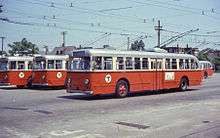
The first trackless trolley line in the Boston transit system was opened by the Boston Elevated Railway (BERy) on April 11, 1936. Replacing a streetcar line over the same route, it was an unnumbered crosstown line running from Harvard station east to Lechmere station. (Substitution of buses for streetcars on the route had been proposed as early as 1930.)[3] Additional lines were opened in 1937, and by 1942, the system had 14 lines, of which 10 were former streetcar lines and four were former motor bus lines.[2] In 1947, the BERy was succeeded by the public Metropolitan Transit Authority (MTA) as the operator of Boston's urban transit system,[2] and in 1964, the MTA was replaced by the Massachusetts Bay Transportation Authority (MBTA), which remains the system's operator today.[4]
The BERy was owned by private investors, but came under public control from 1918. It served 13 municipalities of Greater Boston, including Boston proper. The MTA's service area was limited to these municipalities (with the addition of Revere). Following a change of management, the MTA began replacing trolleybuses with motorbuses, starting in 1958. Only four trolleybus lines remained after 1963, all based in Cambridge. Four decades later, the MTA's successor, the MBTA, built the Silver Line (Waterfront), and that line's opening in late 2004 reintroduced trolleybus service in Boston proper.
At the trolleybus system's peak, the maximum number of trolleybus routes in operation was 37, with most route running in the near north suburbs of Boston. In addition, there were the disconnected Dorchester and Arborway networks.
Prior to the opening of the Silver Line, a total of 43 trolleybus lines had historically existed, but not all concurrently,[4] making the all-time total 44 with route SL1, as of 2014.
Harvard-based routes
History
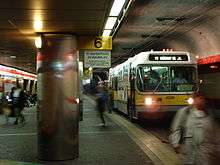
What became the Harvard-based trolleybus system began as branches of the Cambridge Railroad, a horsecar street railway that opened in 1856. Lines from Harvard Square to Mount Auburn via Brattle Street and Porter Square opened soon after the Harvard Square–Bowdoin Square route.[5][6] The connecting Watertown Horse Railroad opened on April 27, 1857.[7] The Porter Square branch was extended to the border of West Cambridge (now Arlington); there it met the West Cambridge Horse Railroad, which opened on June 13, 1859.[6][8] In 1880, the Watertown line was extended south on Galen Street to Nonantum Square.[9]
The Harvard–Arlington line was electrified on July 1, 1889 – one of the first lines converted by the West End Street Railway.[10] Electric service between Watertown and Mount Auburn began on December 12, 1893; the line was double-tracked later in the decade.[11][12] Residents of Brattle Street objected to the construction of electric lines; in October 1893, the Board of Railway Commissioners denied the West End permission to run electric streetcars on Brattle Street.[5][13][14] That November, a compromise was worked out where the West End would instead build on Mount Auburn Street (which had been considered in 1891[15]); the line on Concord Avenue and Huron Avenue would be opened within eight months, and the Brattle Street horsecar tracks removed in the same time frame.[16] The Mount Auburn line opened in April or May 1894, with the Concord/Huron line opening later in the year.[17][18][19]
A branch from Mount Auburn to Waverley Square in Belmont opened on October 1, 1898, despite Watertown's opposition earlier than year to widening Belmont Street.[20][21] A branch to Belmont Center opened on June 30, 1906; it was replaced by buses in August 1928 and was never a trackless trolley route.[22][23][24]
The four surviving Harvard-based routes remained after much of the system was converted to diesel and exist, in part, because of the necessity to limit the number of diesel buses in the Harvard bus tunnel. Inside the portals, the tunnel splits into two one-way tunnels, upper and lower. The tunnel for eastbound-northbound vehicles is placed on top of the tunnel for southbound-westbound vehicles.[25] The tunnels first opened for streetcars in 1912, and trolleybuses began using them in 1938.[4] Streetcar service using the tunnel was abandoned in 1958. In a six-year project lasting from 1979 to 1985 (coinciding with the reconstruction of Harvard station during the Northwest Extension of the MBTA Red Line), the tunnel was closed for an extensive rebuilding, which included new platforms and a new northern portal ramp.[4]
Vehicles
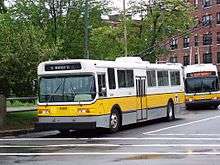
In the lower/westbound tunnel, the loading platforms are located on the left side of the roadway, and for this reason the trolleybuses serving this station have always been equipped with left-side doors, in addition to the normal righthand doors, as state DPU regulations discourage boarding passengers from doors facing the wall rather than the platform. Diesel buses serving the tunnel are not equipped with left-side doors, and passengers boarding or deboarding at the westbound stop must cross the roadway to reach the buses' doors.[25] In 2004, the MBTA began receiving a fleet of new trolleybuses from Neoplan USA, to replace Flyer E800 trolleybuses dating from 1976. The newer vehicles are low-floor vehicles and meet Americans with Disabilities Act standards (see MBTA accessibility).
Current operations
The vehicles are all stored overnight at the North Cambridge Carhouse, the northern terminus of the 77A route. Trackless trolleys do not run on Sundays; instead, diesel buses cover the routes.
To expedite passenger boarding through a left-side door in the southbound Harvard bus tunnel, the 71 and 73 trackless trolley routes allow free entry for outbound trips, collecting fare upon later passenger exit from the vehicle. Diesel buses lack a left-side door, so on Sundays these buses are boarded in the northbound tunnel.
71
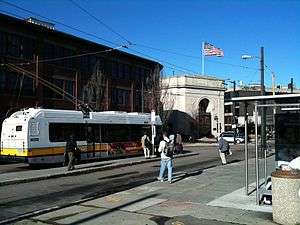
The 71 Watertown Square–Harvard station begins at the Harvard bus tunnel lower level and leaves via the south exit onto Mount Auburn Street. It heads west into Watertown, ending at Watertown Square.
At the Harvard end, to turn around, the trackless trolley exits the tunnel and makes a hard left onto Massachusetts Avenue and a right on Garden Street, and then turns right on Waterhouse Street and right on Massachusetts Avenue to return to the tunnel. The Watertown end has a loop on private right-of-way for turning around and picking up/dropping off passengers.
September 4, 1958, was the last day of streetcar service on the 71; trackless trolleys have run since then. On December 22, 2019, additional reverse-peak short turns were added. These trips serve Mount Auburn Hospital and return trolleybuses to the route 72 terminals for its peak-direction-only service.[26]
72
The 72 Aberdeen Avenue–Harvard station starts on the upper level and comes out the north end of the tunnel, using the path that the 71 uses to turn around. However, at the intersection of Garden and Waterhouse Streets, the 72 heads west on Garden Street, Concord Avenue and Huron Avenue and south on Aberdeen Avenue to end at Mount Auburn Street, intersecting the 71 and 73.
To turn around, the 72 leaves the south portal of the tunnel and turns left on Mount Auburn Street. It turns right on Eliot Street, right on Bennett Street and right on a private right-of-way called Bennett Alley to go straight across Mount Auburn Street into the tunnel. At the west end, the 72 simply makes a U-turn across the wide median of Aberdeen Avenue. On Saturday evenings and Sundays, the 72 is combined with the 75 bus and the route extends to Belmont Center as a diesel bus (signed as route 72/75).
Streetcars last ran on the 72 on April 1, 1938; trackless trolleys have been running since then. In March 2013, the route was temporarily replaced with diesel buses to permit roadwork on Huron Avenue and reconstruction of the Conductor's Building in Bennett Alley.[27] It will return to electric operation when construction is complete. However, route 72 was reduced to peak-direction, peak-hour-only service on December 22, 2019 in conjunction with improvements to routes 74 and 75 (which also run on Concord Avenue).[28]
73
The 73 Waverley Square–Harvard station follows the same route as the 71 in Cambridge. It leaves Mt. Auburn St. to follow Belmont Street, which forms a border between Belmont and Watertown, then continues on Trapelo Road in Belmont to end at Waverley Square, with a loop at the Waverley commuter rail station on the Fitchburg Line. A short-turn loop exists at Benton Square, the intersection of Belmont Street and Trapelo Road.
September 4, 1958, was the last day of streetcar service on the 73 (and 71 and 77A), after which trackless trolleys have run. As a streetcar line, the turnback loop was further west along Trapelo Road at Cushing Square. Streetcars first ran to Waverley Square on October 1, 1898.
In September 2013, the route was converted to diesel buses for two years to permit diversions during roadway reconstruction in Belmont. Trackless trolley service was restored in December 2016. A small number of Benton Square short turns (added to the schedule in March 2016) continue to operate as diesel buses.[27]
77A
The 77A is a short-turn trip of the 77 Arlington Heights–Harvard station bus route. It is not a full-service route; it is primarily a designation for route 71 and 73 trolleybuses to run in revenue service while pulling in or out of the North Cambridge Carhouse. The route was originally a full-service short turn route; however, it became less necessary after the Red Line was extended to Porter and Davis stations in 1984. Since January 2005, the only 77A trips are pull-ins and pull-outs to take 71 and 73 buses to or from the carhouse.[27] They are listed in the 77 schedule.
September 4, 1958, was the last day of streetcar service on the 77A, after which trackless trolleys have run. (Route 77 had already been running diesel buses since 1955.) Until around 1967, the route was numbered 82.
Silver Line
.jpg)
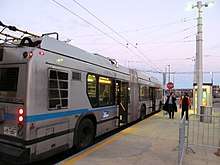
The Silver Line is split into two sections; the diesel-electric hybrid Washington Street section runs entirely on the surface, but the Waterfront section runs through a dedicated tunnel under the South Boston Waterfront, in which diesel emissions would be problematic. Several routes branch out from the tunnel along routings where installation of overhead trolley wire would have been impractical, especially through the Ted Williams Tunnel (as overhead wires are expressly prohibited on interstate highways), so the Waterfront section uses dual-mode buses. The vehicles run as trolleybuses within the tunnel, then change to diesel power at Silver Line Way, and reverse the transition when inbound. Motor buses are not permitted to operate inside the South Boston Waterfront tunnel due to insufficient ventilation.
Four routes run in the electrified Silver Line tunnel: SL1 to Logan Airport, SL2 to Design Center, SL3 to Chelsea, and a shuttle route which short turns at Silver Line Way.
Until early 2006, the Silver Line also used some of the then-new Neoplan trackless trolleys until the entire dual-mode fleet could be placed into service. Later that year, the Neoplan trackless trolleys were transferred to the Harvard-based routes to replace the then-remaining Flyer trolleybuses.
Fleet
Past fleet
Boston's first trolleybuses were built by Pullman-Standard in 1936. Boston Elevated continued to buy its trolleybuses almost exclusively from Pullman, and until 1950 Pullmans comprised the entire fleet with the exception of a small batch of five Twin Coach trolleybuses purchased in 1937.[2][29] In 1952, Boston had more Pullman-built trolleybuses than any other city, with 438.[29]:7 Meanwhile, 25 ACF-Brill trolleybuses built in 1950 were the only other purchase of non-Pullman trolleybuses until 1976. With several route closures in 1964, the Twin Coaches and the oldest Pullmans were retired, leaving only Pullmans built in 1947–51 in service. These were all replaced in 1976 by a fleet of 50 Flyer E800s.[25] The Flyers were, in turn, replaced by new trolleybuses over the period 2004–06.
Current fleet
The present fleet is made up of low-floor vehicles built by Neoplan USA and fitted with Škoda electrical equipment. There are two distinct groups: The network serving Cambridge and vicinity uses a fleet of 28 40-foot (12 m) vehicles, while the Silver Line (Waterfront) uses a fleet of 32 60-foot (18 m) articulated dual-mode buses which are extended-length.
The Cambridge trolleybuses (numbered 4101–4128) were delivered in 2004 and were the first low-floor trolleybuses in North America.[30] The first day of service for trolleybuses in this series was June 4, 2004.[31] The dual-mode, articulated vehicles (numbered 1101–1132) were delivered in 2004–2005 and are also low-floor vehicles.
References
- Murray, Alan (2000). World Trolleybus Encyclopaedia. Yateley, Hampshire, UK: Trolleybooks. p. 79. ISBN 0-904235-18-1.
- Sebree, Mac; Ward, Paul (1974). The Trolley Coach in North America. Los Angeles: Interurbans. pp. 32–39. LCCN 74020367.
- "Council Can't Raise Salaries". Boston Globe. February 26, 1930. p. 11 – via Newspapers.com.

- Wolinksy, Julian (Fall 1988). "Trackless But Loved in Boston". Bus World. Woodland Hills, California: Stauss Publications. pp. 6–10. ISSN 0162-9689.
- "Cambridge Row". Boston Globe. September 15, 1893. p. 4 – via Newspapers.com.

- "Streetcar Barns" (PDF). Cambridge Historical Commission. 2000.
- "Miscellaneous Items". New England Farmer. May 2, 1857. p. 3 – via Newspapers.com.

- Duffy, Richard A. (1997). Arlington. Arcadia. p. 17. ISBN 9780738590431 – via Google Books.
- "Street Railways". Eighteenth Annual Report of the City Engineer for the Year Ending December 31, 1898. Graphic Press. 1899. p. 96 – via Google Books.
- "Increase of $4,500,000". Boston Globe. July 26, 1889. p. 8 – via Newspapers.com.

- "Joined By Electric Bands". Boston Globe. December 12, 1893. p. 4 – via Newspapers.com.

- "To Widen Mt Auburn Street". Boston Globe. December 10, 1894. p. 3 – via Newspapers.com.

- "Cambridge". Boston Globe. June 22, 1893. p. 4 – via Newspapers.com.

- "Objectors Win". Boston Globe. October 31, 1893. p. 12 – via Newspapers.com.

- "Electrical Road Extension". Boston Globe. July 22, 1891. p. 10 – via Newspapers.com.

- "Granted Mt Auburn St". Boston Globe. November 29, 1893. p. 5 – via Newspapers.com.

- "All Unruffled". Boston Globe. March 31, 1894. p. 7 – via Newspapers.com.

- "Settled the Controversy". Boston Globe. May 23, 1894. p. 4 – via Newspapers.com.

- "Squirmed and Twisted". Boston Globe. May 19, 1894. p. 5 – via Newspapers.com.

- "Waverley Celebrates". Boston Globe. October 2, 1898. p. 17 – via Newspapers.com.

- "Watertown Indignant". Boston Globe. June 20, 1898. p. 3 – via Newspapers.com.

- "Belmont Electrics". Cambridge Chronicle. June 30, 1906. p. 14 – via Cambridge Public Library.

- "Belmont Bus Service to be Continued". Cambridge Chronicle. August 25, 1928. p. 2 – via Cambridge Public Library.

- "Buses Take Place of Belmont Car Line". Cambridge Chronicle. August 10, 1928. p. 7 – via Cambridge Public Library.
- Priestley, John (July–August 1988). "North American Safari: Part 3". Trolleybus Magazine, pp. 83–88. National Trolleybus Association (UK). ISSN 0266-7452.
- "Changes to Bus Route 71". Massachusetts Bay Transportation Authority. December 2, 2019.
- Belcher, Jonathan. "Changes to Transit Service in the MBTA district" (PDF). NETransit.
- "Changes to Bus Route 72". Massachusetts Bay Transportation Authority. December 2, 2019.
- Clarke, Bradley H. (1970). The Trackless Trolleys of Boston. Boston Street Railway Association. LCCN 74014950.
- Box, Roland (July–August 2010). "More about the 2000s". Trolleybus Magazine No. 292, pp. 78–82. National Trolleybus Association (UK). ISSN 0266-7452.
- Trolleybus Magazine No. 257 (September–October 2004), p. 123.
External links
| Wikimedia Commons has media related to Trolleybuses in Greater Boston. |
- MBTA – Bus
- MBTA – Route 71 Watertown Square–Harvard Station via Mt. Auburn St.
- MBTA – Route 72 Huron Ave.–Harvard Station via Concord Ave.
- MBTA – Route 73 Waverley Sq.–Harvard Station via Trapelo Road
- MBTA – Route 77 Arlington Heights–Harvard Station via Massachusetts Ave.
- nycsubway.org – Boston Transit: Trolleybuses